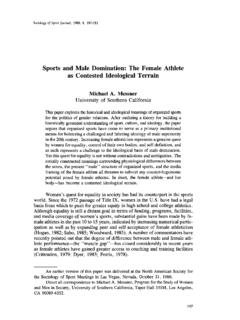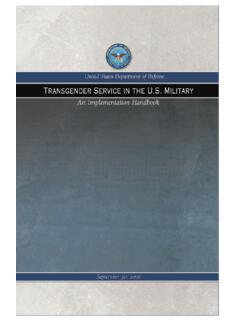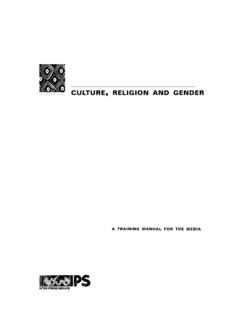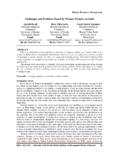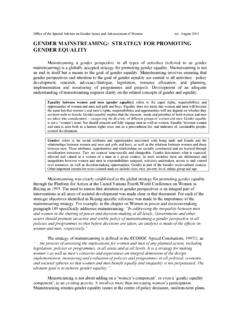Transcription of A Study on women education in India
1 105 A Study on women education in India A. Subangini devi Department of Management Studies, Sri Vidya Mandir Arts and Science College, Uthangarai, India 636902 Received: 21 August 2014: Received in revised form 27 September 2014; Accepted 10 October 2014 AbstractThe basic unit of society is a woman. As women makes a family, family makes a home and homes make a society. So we should never think that a society would come into existence without the contribution of women . The complete responsibility lies on the shoulders of the male to educate and encourage the females to step forward and to play their role in developmental processes of the family. It is also crucial for women access to the legal system.
2 education is a critical input in human resource development and is essential for the country s economic growth. This Study conducts a Study on women education in India . Keywords: Society; education ; responsibility; development; knowledge 2014 Sri Vidya Mandir Arts & Science College, Uthangarai1. IntroductionWomen are the inherent part of our society and cannot be neglected due to their less power and authority. They are created as a companion for men and men have to make her walk with them in the course of life. The Indian female s role and behaviors are defined by laws and as such are given divine sanction.
3 She plays roles as a mother, a sister, a daughter, a wife. They play their roles with great responsibilities in upbringing of a healthy solid society, but she is in our so called modern world, still living in basic unit of society is a woman. As woman makes a family, family makes a home and homes make a society. So we should never think that a society would come into existence without the contribution of women . We all know that without education , no development is possible. Here we have forgotten that the very first and best school of a child is its mother s lap. A good healthy society doesn t automatically emerge on its own and stands firm but it needs to be emerged and for its emergence women play a pivotal role. The role of Indian women in their families revolves around well-established conventions of male supremacy and female sub-ordinance.
4 Here the complete responsibility lies on the shoulders of the male to educate and encourage the females to step forward and to play their role in developmental processes of the family. women are not only for home-making and child-rearing but they must also be given chance to put their hands a little forward in building up of a good solid society. 2. women s EducationWomen education in India plays a key role in the social and economic development of the country. Educating a woman uplifts her life as well as the quality Devi / International Journal of Science, Technology and Humanities 1 (2014) 105-110*Corresponding :+91 9688428365. E-mail address: 2014 Sri Vidya Mandir Arts & Science College, UthangaraiInternational Journal of Science, Technology and Humanities 1 (2014) 105-110 Available online at Journal of Science, Technology and Humanities106of her life and her entire family.
5 It is a fact that any educated woman will definitely support the education of her children especially a girl child and provide a better guidance to her children. An educated woman will easily imbibe an independent and progressive outlook in her children. More importantly, an educated woman in a society like India will assist in reducing the infant mortality rate and control the blossoming of the population. empowerment. Because of the negative perception of women in India , this article examines reasons behind the neglecting of women education , importance of women education , importance of women education in India and what the Indian government is doing to reverse the have a much lower literacy rate than men. Far fewer girls are enrolled in the colleges and many of them drop out.
6 In the patriarchal setting of the Indian family, girls have lower status and fewer privileges than boy children. A conservative cultural attitude prevents some girls from attending colleges. Recently the Indian government has launched Saakshar Bharat Mission for female Literacy. This mission aims to bring down female illiteracy by half of its present level. The education of women in India plays a significant role in improving livings standards in the country. A higher women literacy rate improves the quality of life both home and outside of home, by encouraging and promoting education of children, especially female children, and in reducing the infant mortality rate. 3. Objectives of the studyThe researcher has framed the following objectives to analyze the Study area1.
7 To Study the history of women To analyze the problems of women To Study the importance of women education4. History of women education Go where no one else will go, do what no else will do -Mary LyonBefore and after Independence, India has been taking active steps towards women s status and education . The 86th Constitutional Amendment Act, 2002, has been a path breaking step towards the growth of education , especially for females. According to this act, elementary education is a fundamental right for children between the ages of 6 and 14. The government has undertaken to provide this education free of cost and make it compulsory for those in that age group. This undertaking is more widely known as Sarva Shiksha Abhiyan (SSA).Since then, the SSA has come up with many schemes for inclusive as well as exclusive growth of Indian education as a whole, including schemes to help foster the growth of female major schemes are the following: Mahila Samakhya Programme: This programme was launched in 1988 as a result of the New education Policy (1968).
8 It was created for the empowerment of women from rural areas especially socially and economically marginalized groups. When the SSA was formed, it initially set up a committee to look into this programme, how it was working and recommends new changes that could be made. Kasturba Gandhi Balika Vidyalaya Scheme(KGBV): This scheme was launched in July, 2004, to provide education to girls at primary level. It is primarily for the underprivileged and rural areas where literacy level for females is very low. The schools that were set up have 100% reservation: 75% for backward class and 25% for BPL (below Poverty line) females. National Programme for education of Girls at Elementary Level (NPEGEL): This programme was launched in July, 2003. It was an incentive to reach out to the girls who the SSA was not able to reach through other schemes.
9 The SSA called out to the hardest to reach girls . This scheme has covered 24 states in India . Under the NPEGEL, model schools have been set up to provide better opportunities to notable success came in 2013, when the first two girls ever scored in the top 10 ranks of the entrance exam to the Indian Institutes of Technology (IITs). Sibbala Leena Madhuri ranked eighth, and Aditi Laddha ranked Devi / International Journal of Science, Technology and Humanities 1 (2014) 105-110107 Until recently, women have largely been excluded from the educational system. It may surprise you to know that while Harvard opened in 1636, the first college to admit women did not do so far another 200 years. women did not begin attending college in equal numbers to men until as recently as 1980.
10 education is something women today often take for granted and they do not think about all of the hard work it took to attain right to education . In the past, women with little education often believed that they were not capable of things like participating in politics, having a carrier or even owing property. women who were lucky enough to have received a quality education were more likely to be pioneers in civic activism and make history by understanding the history of women s education one is able to better appreciate how far we have come and the extraordinary women who got us here. 5. Review of literature When 10% more girls go to school, a country s GDP increases on average by 3% -Ayni education InternationalThe Oxford Dictionary defines women problem solving technique as Efforts to make life worth living for women students.
![Gender Equality and Women's Empowerment in India [OD57]](/cache/preview/0/7/f/d/9/7/1/6/thumb-07fd97166dd92c7359501888c42037d3.jpg)
